
(Photos: Dan Kaufman)
A reader that lives in Sellwood has shared news and photos of the Oaks Bottom Trail submerged under several inches of water. The trail is a key connection from the popular Spingwater Corridor Trail to McLoughlin Boulevard (99E) where it intersects with Milwaukie Ave.
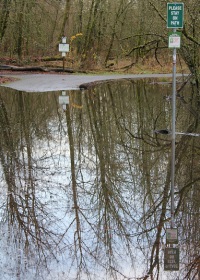
Dan Kaufman can see the flooded area from the deck in his backyard. He says the flooding is passable by bike (as long as you don’t try to pedal), but it has turned some people back. “I have seen cyclists turn around to avoid it.” Kaufman says if you’re walking on the trail, you’d better have some rubber boots.
Kaufman says he’s tried to have the City of Portland alleviate the flooding, but, “They won’t do anything about it.” He says he sometimes sees a “road closed” sign at the top of the hill (where the trail emerges at McLoughlin), but feels the issues would be treated differently “if it were a motor road.” Making this issue more complicated is that this trail goes right through a pond and sensitive habitat that is being restored by City of Portland Parks.
Here’s a map of the location where the trail is flooded…

See more photos in Dan Kaufman’s photo gallery.
Do you ride through this area? If you have been impacted by this flooding, please share your experiences below.
UPDATE: I heard from Portland Parks spokesperson Beth Sorensen. She says the trail was designed for the water to go underneath, but the ground is “oversaturated” and “it’s [the trail] isn’t designed for that much water.” Here’s more from Sorensen:
“That’s a protected wetland area so we are obligated to not go in there and mess around with it. That area is also red-legged frog species and we’re required by state and federal law to protect the species… On either side of that trail you’ll find that species so we’ll have to be really careful about how things are handled in that area. If people go through there by bike or on foot, please stay on the trail.”
Sorensen also said that Portland Parks has explored funding for a raised trail in this area to solve these issues, but that funding for such a project isn’t likely in the short-term.

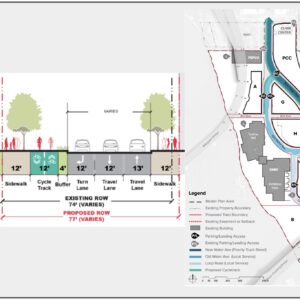
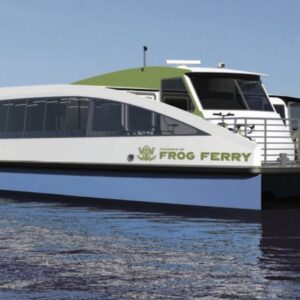
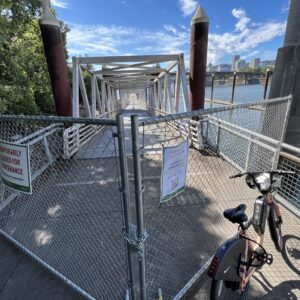
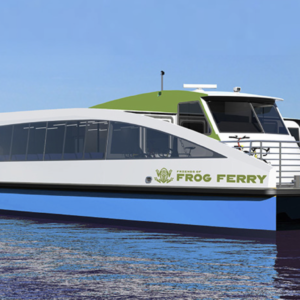
Thanks for reading.
BikePortland has served this community with independent community journalism since 2005. We rely on subscriptions from readers like you to survive. Your financial support is vital in keeping this valuable resource alive and well.
Please subscribe today to strengthen and expand our work.
Hardly, I go by on Springwater to/from Milwaukie… There is a puddle where Springwater and Oaks Bottom intersect under the railroad. I am not aware the OB trail was being flooded. Thank for the head up.
It’s a wetland, it happens.
It’s all Sam Adams fault.
Just what do you expect the city to do? The trail goes through a pond, right? that means it’s on a creek, right? Which creek will continue feeding water in as it’s pumped out till water levels drop.
After the rains, nag PDOT to raise the path at the spot–someone should mark the boundaries of the flooding with high-viz paint if the city can’t do it immediately.
Till then: shoe covers!
When it rains hard, these things happen.
The clogged storm drains others have reported, that’s something to complain about. Entirely preventable.
Rick and others,
I just posted this update:
I heard from Portland Parks spokesperson Beth Sorensen. She says the trail was designed for the water to go underneath, but the ground is “oversaturated” and “it’s [the trail] isn’t designed for that much water.” Here’s more from Sorensen:
Sorensen also said that Portland Parks has explored funding for a raised trail in this area to solve these issues, but that funding for such a project isn’t likely in the short-term.
That first picture is missing the shark fin slicing through the water after the riders…
cue Jaws theme…
Maybe the streetcar alligator should take up residence here.
worst. article. in. ages.
It is a wetland. The trail shouldn’t even really be there. Wetlands don’t flood, part of their natural cycle is being under water, or “wet” as some would call it.
We have already pumped dry and paved 90% of the wetlands in the country – so complaining about this one wetland getting wet during the rainy season is really just over-the-top bicycle spoiled selfishness. Makes bicyclists look really really really whiny.
Valkraider. Thanks for sharing your opinion. I don’t quite understand why when I report about issues with bikeways/trails/roads, etc… people have to call it complaining.
This is a key connection in our network and many people bike through it every day. I think the fact that it’s submerged under water is important and I think educating people about the issues surrounding the trail (who manages it, what constraints its under, etc..) is much more than simply “complaining.”
I would guess the comments Valkraider is refering to are that the City of Portland “won’t do anything about it.” and that they would treat it differently if it were a motor road.
That certainly sounds like a complaining to me, regardless of who said it.
Prior to your update, those statements constituted the bulk of your post.
I use this trail quite frequently as a cut-through to reach the Springwater. It’s not lit (and gets very dark because of the tree canopy), has a lot of slow foot traffic, steep grade, blind corners, and is filled with swarming insects (that don’t taste good) 9 months out of the year. Now it’s flooded. And yet, I’m not gonna complain.
The Oaks Bottom Wildlife Refuse trail- and its access to bicycles- is a blessing and a privilege. The alternative is to go all the way south to SE Spokane St or north to the OMSI/99E/big pipe debacle area. The trail doesn’t have to be there and it doesn’t have to be accessible to bicycles- I’m sure the city/county/state could find a way to limit it to peds-only and remove the paved trail.
Because it’s a sensitive habitat, though, a raised walkway (similar to the one on the Springwater east of Sellwood a mile or so) would do a good job of keeping people out of the habitat (and water) as well as providing an easier path for bicycles in the dark.
Thanks for posting this, J. I haven’t been down that trail all week and now I know to go around or be ready for a foot bath! Thanks for the heads-up!
I see the expected reactions.
Just for the record there used to be an adjacent creek that allowed water to flow into the lower half of this wetland. The usually dry creek was FILLED IN by the dirt and debris that was used to make this path. The water does not ever and flow or drain under this path because the gravel underneath filled with silt.
No one is advocating draining these protected wetland or ponds but I am advocating restoring the original creek/water flow which will also allow folks to commute freely by foot or bike.
Making our MUPs usable is important to making them successful. If we consider this trail-head path part of our bicycle/pedestrian network it needs to be maintained. This can be done inexpensively and not to the detriment of the ecosystem.
By the way, complete restoration of the Oaks Bottom wetland is unlikely due to the fact that the area was a dumping ground for soil from the I-405 dig and because of other man-made structures like the Springwater Rail Line/Trail and Oaks Park.
Jonathan: “I don’t quite understand why when I report about issues with bikeways/trails/roads, etc… people have to call it complaining.”
You know that’s not true. There are times, such as the problem you reported with the curve on the Burnside couplet, where you’ve reported an issue and gotten near 100% support the community. I’m pretty sure your issue goes back to the (imo wrong-headed) stance you took on the Esplanade, where there was widespread disagreement with your conclusions.
I think in general people call the problem complaining when it is related to an issue which they deem at most an annoyance. In this particular case the key reason to call this whining is this particular sentence: “He says the flooding is passable by bike (as long as you don’t try to pedal).” In other words, this is at most an inconvenience because the trail is still passable. There’s also the common-sense issue, raised earlier, that when riding through a protected wetland most of us are probably prepared for some high water after a downpour (and really, aren’t most of us prepared for that all over the city?). As mentioned earlier, Dan Kaufman’s complaint that it wouldn’t be like that if it were a “motor road” also comes off as whining in light of the fact that in the days after the last really big downpour there were several streets that had huge lakes near my house. Most of us understand that there will be significant puddles after a heavy rain, that’s why we wear rain gear.
In conclusion, when people think you are editorializing on a trivial issue they’re going to call it complaining. When they think you’re reporting on an issue that has merit, they’ll agree wholeheartedly. Do you expect anything less?
some weird things in the response from Portland Parks…
first, they already messed with it by putting a trail through it…
second, you can’t stay on the path when it’s underwater…
now you can’t see the frogs that you’re running over under the water… so with it flooded and them not helping it drain to normal they’re making it worse…
it seems that the water would also damage the trail by being underwater like that by loosening up the foundation and making it prone to being washed out…
I’m not sure they would do more if it were a path for cars… they always close 92nd between Powell and Division because it is always flooding… and like this trail it’s not a needed connector since there’s nothing there except the path which is just another way to get where all the streets already go…
You know, when our neighborhood goes underwater, the only way to get to a good 100+ houses is by bike. 😀
Except in the deeper areas, where the water comes up to the wheel axles if you’re biking in the street. In which case, it’s a good thing you weren’t in a car!
People, the solution is simple:
http://www.chicagofreakbike.org/flotilla/gf0613.jpg
That’s what happens when you build stuff in a wetland, be it houses, and industrial park, or a bike path.
Thanks for the awesome pics. 🙂
these times are what “tallbikes” were made for!
When a motor road is built, they clear a wide swath, strip away everything organic, fill in any low spots or soft spots, put all the surface channels a.k.a. “streams” in culverts (pipes), set the grade elevation high enough not to be submerged in routine flood events, and use fill material as necessary to build a spreading trapezoid-shaped berm to support the highway, which of course is wider at its bottom, the higher you set the grade. By the time you’re done, you’ve destroyed the hell out of anything natural within a many-feet-wide swath.
It’s happening! Global warming, The ice-caps are melting and oaks bottom is going under, head for higher ground
It’s nature. Let’s celebrate the wetlands.
helmet check
bike lights check
life vest check
As much as I believe in cycling, I have to agree with others who have noted that it’s a wetland. These things happen. That said, from my backpacking experiences, I have noticed that the Appalachian Trail has constructed bog log bridges, and elevated wooden walkways through wetland areas to minimize impact. If the parks department wanted to do a service to the wetlands, they might consider the same thing, instead of using a tar-based asphalt pathway.
A puncheon type structure probably wouldn’t be a good idea for such a heavily used corridor. Wood is slipper when wet and anyways a “floating” structure is going to end up pretty skewed and uneven with that amount of traffic. That said, it would be a good solution for a lot of the walking trails in Oaks bottom.
Close it just like they did Leif Erikson when it had storm damage. No burden is too great in the name of safety!
They need to put little flags on each side of the path so people know where it is.
Yes okay, it is a wetland. WE GET IT.
But even if we can’t rebuild the trail, can we at least acknowledge that its closure is a significant inconvenience for many commuters? I would disagree with Spiffy; maybe it’s “not a needed connector” FOR YOU, but it is for plenty of folks. This is the ONLY place between Tacoma Street and the OMSI area that you can connect between the Springwater trail and surrounding neighborhoods.
I live in the Brooklyn neighborhood and use the path (recreationally) fairly often. Although it is not on my daily commute route, if it were the detour would add 2-3 miles to my trip. I could consider an additional 15 minutes in my commute to be a significant inconvenience.
Again, I’m not proposing to go in and make any changes that would damage frog habitat. We’ll have to live with the closure and the detours, but let’s not pretend that this isn’t an important part of our bikeway network.
My problem is not the reporting of the trail closure. That would be perfectly reasonable.
My problem is that Jonathon – through extensive use of Dan Kaufman’s opinions, followed up by questions to Portland Parks about what can be done to “fix” the “problem” – has framed the discussion incorrectly.
Yes, the trail being flooded can be an inconvenience, and as a 7 year Brooklyn resident I am in complete agreement with you.
But this is not a “problem” in need of a “solution” as it has been framed in this discussion.
Having a wetlands to ride through AT ALL is a wonderful thing, and any discussion should be about how to preserve and protect the wetland. We have plenty of paved surface in the city – we need more wetlands.
I have had the most spiritual nature experiences in Oaks Bottom – and it hurts me to see the bicycle community represented as though we are so annoyed by the wetland that we want it filled in and paved over. I feel that it makes the bicycle community look like a bunch of spoiled whiners to complain about the wetland flooding during the rainy season. It certainly doesn’t help our image…
Perhaps a story like: “Reader Dan Kaufman sent in pictures of Oaks Bottom being flooded. Enjoy the pictures and if this is in your regular route plan for alternatives until the water goes back down.” would have been useful and informative, and shared some great pictures. But instead we have all kind of talk about “solutions” and “funding to solve issues” and “alleviate flooding” and whatnot…
You make some good point
Point taken valkraider. That’s fair criticism. I try to be very sensitive to how I frame things.
It wasn’t my intention to “represent” any community as being “annoyed” by this. And I certainly don’t advocate for having anything “paved over.” My intention was to point out that 1) flooding was happening and 2) it brings up an issue of how our city deals with key transportation routes that go through parks and natural areas (I realize that might not have been clear in the story).
As for “our image.” I don’t write with any image-keeping in mind. I’m not some PR guy for the Portland bike community. People can have whatever opinions they want to have.
I hear you. Thanks for the feedback.
Sorry but there is a problem here and it was created because the builders of the path did not clean up properly after the construction of this path and instead dumped the excess dirt and debris in a dry creek. Yeah, how’s that for eco-sensative?!
I wish the people would stop trying to present a false dichotomy (wetland v. MUP). It’s lazy. That position plus describing folks like myself as spoiled whiners is mean-spirited as it seeks to shut down rational debate.
The solution is not paving over the wetland (duh!) or building an elevated path. It’s restoring the creek. It would take a crew of shovel ready volunteers about a day and I am willing to organize it.
Yes, this is not some giant calamity for cyclists. But what really got me upset is when I saw (what appeared to be a) homeless couple walking through the water in tennis shoes and thinking about how long it will take to get their feet warm and shoes dry again. It matters.
With the help of school kids, other voluneers, and our tax dollars, Parks & Rec has done a masterful job in recent years trying to restore a former landfill. It will be a very long haul, but there has been progress.
Last month a 3-point buck faced off against me in the middle of the bike path while I was descending the grade. Besides the usual assortment of water fowl, herons, kingfishers, ospreys, hawks, and eagles, I spotted a Pileated Woodpeckecker hammering a tree over the very wetland that floods the trail. I’ve had two close calls with skunks in the early morning darkness and shared a moment of wonderment with an owl perched on the cyclone fence near Ross Island S&G. I’d rather have a flooded trail through a struggling wetland than a street full streetcar, light-rail, and train tracks:)
sounds like a good place for a live webcam to watch both nature and bycycles riding through the water
I know- it’s spelled “bicycle”, I just do that sometimes…
I can definately see the point made by those who say that this is a seasonal wetlands. Whether this was once a more passable route before construction damaged it is not something I can say from experience. But it IS passable to those willing to get by. I saw one hiking couple and the lady took off her shoes and gave a piggy-back ride to the guy.
I was riding on a tandem-trike with a young friend and we rode through with no problem (wish I’d had pictures). The water was about 4-5 in deep.